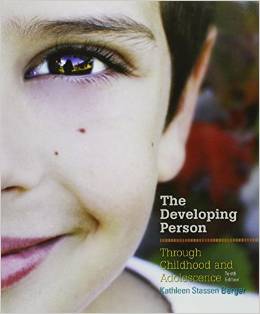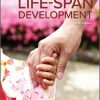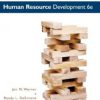Developing Person Through Childhood Adolescence 10th Edition Berger Test Bank
$35.00 Original price was: $35.00.$26.50Current price is: $26.50.
Developing Person Through Childhood Adolescence 10th Edition Berger Test Bank
Developing Person Through Childhood Adolescence 10th Edition Berger Test Bank

Product details:
- ISBN-10 : 146417735X
- ISBN-13 : 978-1464177354
- Author: Kathleen Stassen Berger
Chapter 1: Multiple choice
1. What does the science of human development seek to understand?
A) the meaning of life
B) theories that have not been subjected to scientific testing
C) the works of Freud, Piaget, and Erikson
D) how and why people change over time
2. Dr. Furth wonders if a specific brain chemical can be suppressed if a patient is given a large dose of vitamin E. Dr. Furth’s question demonstrates the _____ step in the scientific method.
A) first
B) second
C) third
D) fourth
3. Dr. Hernandez predicts that a certain drug will help patients with schizophrenia. Her prediction is called _____.
A) a conclusion
B) empirical evidence
C) a hypothesis
D) a result
4. A researcher designed and conducted an experiment to determine whether 350 mg of a certain drug would help patients with bipolar disorder. By designing and conducting this experiment, the researcher was able to _____.
A) draw conclusions
B) demonstrate proof
C) test the hypothesis
D) confirm the results
5. Dr. Henderson is curious to know more about how children develop over time. To avoid relying on opinion or personal bias, Dr. Henderson should _____.
A) use the scientific method to collect data and establish facts
B) have the children undergo psychoanalysis
C) talk with many children’s parents
D) read Dr. Spock’s book, Baby and Child Care
6. The first step in the scientific method involves _____.
A) posing a question
B) conducting research
C) supporting or refuting a hypothesis
D) developing a hypothesis
7. The second step in the scientific method involves _____.
A) posing a question
B) conducting research
C) developing a hypothesis
D) sharing the results
8. The third step in the scientific method involves _____.
A) posing a question
B) conducting research
C) sharing the results
D) developing a hypothesis
9. The fourth step in the scientific method involves _____.
A) posing a question
B) conducting research
C) developing a hypothesis
D) supporting or refuting a hypothesis
10. Empirical evidence is based on _____.
A) theories and speculation
B) observation, experience, or experiment
C) inferences based on personal biases
D) opinions generated by several groups of people
11. After posing a question, a researcher using the scientific method _____.
A) draws conclusions
B) runs an experiment
C) selects a group of participants
D) develops a hypothesis
12. The final step in the five steps of the scientific method is to _____.
A) test a hypothesis
B) pose a question
C) conduct research
D) report the results
13. What is a researcher’s first step when designing a research study on children’s language acquisition?
A) recruit children and their parents as participants in the study
B) develop a hypothesis on the way language is acquired in children
C) pose a research question about language acquisition
D) draw conclusions on the way children acquire language
14. A hypothesis is a(n) _____.
A) experiment
B) prediction that can be tested
C) conclusion drawn from research
D) replication of a scientific study
15. What is replication of a study?
A) the repetition of a study using different participants
B) the repetition of a study using the same participants
C) designing a new study based on information from a previous study
D) designing a new study using new ideas and information
16. Dr. Kong does a study in which he finds that smoking is correlated with an increased risk of high blood pressure. He publishes his results, and Dr. Meco reads the report about the study. Then Dr. Meco does the same study using different participants in another city. Dr. Meco’s work is an example of _____.
A) scientific controversy
B) replication
C) ethics
D) observation
17. Dr. Seldor does a study in which she finds that alcohol consumption is correlated with an increased risk of diabetes. She publishes her results, and Dr. Al-Jaher reads the report about the study. Then Dr. Al-Jaher does the same study using different participants in another nation. Dr. Al-Jaher’s work is an example of _____.
A) scientific controversy
B) replication
C) empirical evidence
D) a hypothesis
18. Parents who spend a great deal of time and money trying to find the best school for their children believe in the importance of _____ as it relates to development.
A) nurture
B) replication
C) nature
D) classical conditioning
19. The term for all the environmental influences that affect development after conception is _____.
A) proteins
B) nurture
C) nature
D) amino acids
20. In the science of human development, “nature” refers to _____.
A) the genes that people inherit
B) environmental influences
C) patterns of development
D) developmental differences
21. In the science of human development, “nurture” refers to _____.
A) universal traits
B) biological traits
C) environmental influences
D) unique traits
22. Most developmental psychologists believe that development is the result of _____.
A) nature and nurture acting separately
B) primarily nature
C) nature and nurture acting together
D) primarily nurture
23. Dr. Towne believes that heredity is primarily responsible for personality traits. Dr. West believes that environmental influences are primarily responsible for personality traits. They are on different sides of the _____ debate.
A) nature versus nurture
B) intelligent design versus evolution
C) genes versus development
D) traits versus conditioning
24. Susie, who is 5 years old, is the tallest person in her kindergarten class. When her teacher asked her how she got so tall she said proudly, “My mom and dad are tall and I eat good food!” Susie’s statement reflects that she understands that human development comes from _____.
A) heredity
B) the environment
C) learning
D) environment and heredity combined
25. Which is an example of the influence of nature?
A) having a mother who smoked during pregnancy
B) having the gene for epilepsy
C) eating a healthy diet
D) living in a loud neighborhood
26. Dr. Janney recognizes that developmental milestones rely on factors from all three domains of human development. Dr. Janney most clearly follows the _____ perspective.
A) biosocial
B) cognitive
C) psychosocial
D) biopsychosocial
27. The _____ domain includes development of emotions, temperament, and social skills.
A) biosocial
B) cognitive
C) psychosocial
D) biopsychosocial
28. The _____ domain includes all the mental processes that a person uses to obtain knowledge or to think about the environment.
A) biosocial
B) cognitive
C) psychosocial
D) biopsychosocial
29. The _____ domain includes all the growth and change that occur in a person’s body and the genetic, nutritional, and health factors that affect that growth and change.
A) biosocial
B) cognitive
C) psychosocial
D) biopsychosocial
30. The human fetus develops fingers and toes between 28 and 54 days after conception but cannot develop fingers and toes before or after that time. This is an example of _____.
A) a sensitive period
B) a critical period
C) discontinuity
D) continuity
31. Which example clearly illustrates a critical period?
A) a child learning to walk
B) a child learning a second language before age 4
C) a fetus developing fingers and toes between 28 and 54 days in utero
D) a child learning to ride a bike between 5 and 6 years of age
32. Which example clearly illustrates a sensitive period?
A) a child being born blind
B) an egg being fertilized
C) a fetus developing fingers and toes
D) a child learning to speak a second language
33. Between 1957 and 1961, many pregnant women took thalidomide to alleviate morning sickness; this drug disrupted a(n) _____ period of prenatal development.
A) sensitive
B) critical
C) early
D) late
34. A woman in Honduras worked in a field treated with pesticides during her pregnancy. When her son was born, she was horrified to find that he had no limbs. Her pesticide exposure must have occurred during a(n) _____ period of prenatal development.
A) critical
B) early
C) late
D) sensitive
35. Bobby was not taught to read until he was an adolescent. When he did learn to read it was much harder for him to learn and it took him longer to learn to read than it would have during his early- to middle-childhood years. Bobby had a hard time learning to read because he did not learn to do so during the _____ period.
A) critical
B) early
C) late
D) sensitive
36. Which term is associated with Urie Bronfenbrenner’s ecological-systems approach?
A) mastosystems
B) microsystems
C) extrasystems
D) intrasystems
37. In Bronfenbrenner’s ecological-systems approach, the _____ refers to the interactions among systems.
A) macrosystem
B) exosystem
C) microsystem
D) mesosystem
38. What term did Bronfenbrenner use to describe the impact of the specific time in history on a person’s development?
A) macrosystem
B) exosystem
C) microsystem
D) chronosystem
39. Dorothy was born during the Great Depression. Within the context of the ecological-systems approach, knowing this fact allows one to know about her _____.
A) chronosystem
B) exosystem
C) microsystem
D) macrosystem
40. Dwayne was born to a single mother living in Chicago. Within the context of the ecological-systems approach, knowing this fact allows one to know something about his _____.
A) chronosystem
B) exosystem
C) microsystem
D) macrosystem
41. Dr. Kilbey is studying the impact of exosystems on human development. Which of these would she be most interested in examining?
A) cultural values and economic processes
B) family and peer groups
C) medical centers and religious institutions
D) the development of the skeletal structure in children
42. The ecological-systems approach was proposed by _____.
A) Maslow
B) Baltes and Baltes
C) Bronfenbrenner
D) Skinner
43. In Bronfenbrenner’s ecological-systems model, a hospital in the community is an example of which system?
A) the ecosystem
B) the microsystem
C) the health-care system
D) the exosystem
44. In Bronfenbrenner’s ecological-systems model, family and peers are part of a person’s _____.
A) microsystem
B) exosystem
C) macrosystem
D) social system
45. A person’s macrosystem includes _____.
A) political processes
B) the peer group
C) school and church
D) historical setting
46. Within Bronfenbrenner’s ecological-systems approach, he called the historical context that affects other systems the _____.
A) ecosystem
B) chronosystem
C) mesosystem
D) macrosystem
47. Bettie belongs to one cohort; Zahara belongs to another. The only required difference between these two women is _____.
A) membership in community groups
B) socioeconomic status
C) age
D) ethnic or racial group
48. High school classmates are part of the same _____.
A) social construction
B) network
C) socioeconomic status
D) cohort
49. The people in which of the following groups are DEFINITELY members of the same cohort?
A) women who are pilots
B) men with learning disabilities
C) citizens of the United States
D) current middle school students
People also search:
the developing person through childhood and adolescence 10th edition pdf
what is development in child and adolescent
is adolescence part of childhood
how do adolescent grow and develop











